-
 Bitcoin
Bitcoin $106,754.6083
1.33% -
 Ethereum
Ethereum $2,625.8249
3.80% -
 Tether USDt
Tether USDt $1.0001
-0.03% -
 XRP
XRP $2.1891
1.67% -
 BNB
BNB $654.5220
0.66% -
 Solana
Solana $156.9428
7.28% -
 USDC
USDC $0.9998
0.00% -
 Dogecoin
Dogecoin $0.1780
1.14% -
 TRON
TRON $0.2706
-0.16% -
 Cardano
Cardano $0.6470
2.77% -
 Hyperliquid
Hyperliquid $44.6467
10.24% -
 Sui
Sui $3.1128
3.86% -
 Bitcoin Cash
Bitcoin Cash $455.7646
3.00% -
 Chainlink
Chainlink $13.6858
4.08% -
 UNUS SED LEO
UNUS SED LEO $9.2682
0.21% -
 Avalanche
Avalanche $19.7433
3.79% -
 Stellar
Stellar $0.2616
1.64% -
 Toncoin
Toncoin $3.0222
2.19% -
 Shiba Inu
Shiba Inu $0.0...01220
1.49% -
 Hedera
Hedera $0.1580
2.75% -
 Litecoin
Litecoin $87.4964
2.29% -
 Polkadot
Polkadot $3.8958
3.05% -
 Ethena USDe
Ethena USDe $1.0000
-0.04% -
 Monero
Monero $317.2263
0.26% -
 Bitget Token
Bitget Token $4.5985
1.68% -
 Dai
Dai $0.9999
0.00% -
 Pepe
Pepe $0.0...01140
2.44% -
 Uniswap
Uniswap $7.6065
5.29% -
 Pi
Pi $0.6042
-2.00% -
 Aave
Aave $289.6343
6.02%
Must the gap be filled? Three exceptions must be vigilant!
In crypto trading, "filling the gap" occurs when price returns to a level skipped during rapid movement, though not all gaps get filled due to strong momentum or market shifts.
Jun 15, 2025 at 09:22 pm
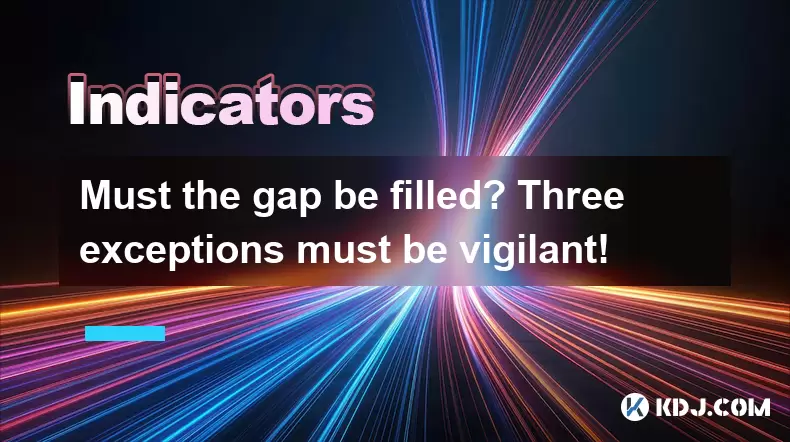
What Does "Filling the Gap" Mean in Cryptocurrency Trading?
In cryptocurrency trading, "filling the gap" refers to the price returning to a level that was skipped during a rapid price movement. Gaps often occur due to sudden market reactions, such as news events or major exchange outages. When the price retraces to the area of the gap, it is said to have filled it. Many traders believe that gaps tend to get filled over time, but this is not always the case in the highly volatile crypto market.
Understanding how and why gaps form helps traders anticipate future price action. For instance, a gap-up occurs when the opening price is significantly higher than the previous day’s closing price, while a gap-down happens when the opening price is much lower.
Why Some Gaps Never Get Filled
Despite the general belief that gaps are eventually filled, there are exceptions. In fast-moving markets like cryptocurrencies, certain conditions may prevent gaps from being filled:
- Strong momentum: If a coin experiences strong buying or selling pressure, the price may continue moving without revisiting the gap zone.
- Structural changes: Events like halvings or protocol upgrades can cause irreversible shifts in price behavior.
- Market sentiment shifts: Sudden changes in investor perception can make old price levels irrelevant.
These factors contribute to scenarios where gaps remain unfilled, challenging traditional technical analysis assumptions.
Exception 1: Breakaway Gaps and Their Significance
A breakaway gap marks the beginning of a new trend. It typically appears at key support or resistance levels and signals a strong shift in market direction. Unlike common gaps, breakaway gaps are rarely filled because they represent a breakout rather than a temporary imbalance.
Identifying a breakaway gap involves analyzing volume and price patterns. A surge in volume accompanying the gap confirms its validity. Traders should look for:
- A clear departure from a consolidation pattern
- Increased trading volume on the gap day
- Confirmation through subsequent candlestick formations
Once confirmed, these gaps serve as reliable indicators of future price direction, making them one of the three critical exceptions where filling is unlikely.
Exception 2: Runaway (Measuring) Gaps and Continuation Patterns
Runaway gaps, also known as measuring gaps, appear mid-trend and indicate sustained momentum. These gaps reflect continued buying or selling pressure and often act as halfway points in a larger move.
Traders use runaway gaps to estimate the potential length of a trend. The distance between the start of the trend and the runaway gap is mirrored after the gap to project the target price.
Key characteristics include:
- Occurrence within an established trend
- High volume confirming the continuation
- Lack of nearby support or resistance zones
Since these gaps reflect ongoing strength or weakness, they rarely get filled unless there's a significant reversal.
Exception 3: Exhaustion Gaps and Trend Reversals
An exhaustion gap forms near the end of a trend and signals a final push before a reversal. Unlike breakaway or runaway gaps, exhaustion gaps are often followed by a sharp reversal, which might lead some to believe the gap will be filled quickly.
To distinguish an exhaustion gap from a runaway gap:
- Look for unusually high volume followed by a swift reversal
- Observe extreme price spikes with long wicks
- Check for divergence in technical indicators like RSI or MACD
While exhaustion gaps may get partially filled, they do not always fully retrace, especially if the reversal is strong and sustained.
How to Trade Around Gaps Without Expecting Them to Fill
Given that not all gaps get filled, traders must adapt their strategies accordingly. Here’s how to approach gap trading effectively:
- Classify the type of gap: Determine whether it's a breakaway, runaway, or exhaustion gap using volume and chart context.
- Avoid automatic assumption of fill: Do not base trades solely on the expectation that the gap will close.
- Use confluence with other indicators: Combine gap analysis with support/resistance, moving averages, and volume profiles.
- Set realistic stop-loss and take-profit levels: Base your risk management on actual market structure, not historical norms.
By understanding the nature of each gap and adjusting expectations, traders can avoid costly misjudgments.
Frequently Asked Questions
Q: Can gaps in cryptocurrency be used for arbitrage opportunities?
A: While gaps can create short-term arbitrage across exchanges, they are not directly tied to the concept of filling gaps in price charts. Arbitrage relies on price discrepancies between platforms rather than retracing movements.
Q: How do overnight gaps affect crypto positions held long-term?
A: Overnight gaps can significantly impact open positions, especially in leveraged trades. Long-term investors may experience volatility but are less concerned with short-term price skips.
Q: Is it possible for multiple gaps to appear consecutively without any being filled?
A: Yes, especially during periods of intense market activity or panic. Consecutive gaps often occur during major news cycles or regulatory announcements.
Q: Do gaps behave differently on various timeframes in crypto charts?
A: Absolutely. Shorter timeframes like 1-hour or 4-hour charts see more frequent but less meaningful gaps. Daily and weekly charts offer more reliable gap signals aligned with broader market trends.
Disclaimer:info@kdj.com
The information provided is not trading advice. kdj.com does not assume any responsibility for any investments made based on the information provided in this article. Cryptocurrencies are highly volatile and it is highly recommended that you invest with caution after thorough research!
If you believe that the content used on this website infringes your copyright, please contact us immediately (info@kdj.com) and we will delete it promptly.
- 2025-W Uncirculated American Gold Eagle and Dr. Vera Rubin Quarter Mark New Products
- 2025-06-13 06:25:13
- Ruvi AI (RVU) Leverages Blockchain and Artificial Intelligence to Disrupt Marketing, Entertainment, and Finance
- 2025-06-13 07:05:12
- H100 Group AB Raises 101 Million SEK (Approximately $10.6 Million) to Bolster Bitcoin Reserves
- 2025-06-13 06:25:13
- Galaxy Digital CEO Mike Novogratz Says Bitcoin Will Replace Gold and Go to $1,000,000
- 2025-06-13 06:45:13
- Trust Wallet Token (TWT) Price Drops 5.7% as RWA Integration Plans Ignite Excitement
- 2025-06-13 06:45:13
- Ethereum (ETH) Is in the Second Phase of a Three-Stage Market Cycle
- 2025-06-13 07:25:13
Related knowledge

How to set the stop profit point after the high-level propeller pattern?
Jun 16,2025 at 08:04pm
Understanding the High-Level Propeller PatternThe high-level propeller pattern is a technical analysis formation often observed in cryptocurrency trading charts. It typically appears at significant price peaks and signals potential reversals. The pattern consists of a large candlestick with long upper and lower shadows, resembling a propeller, indicatin...

When is the most reasonable stop loss after the three crows pattern?
Jun 16,2025 at 08:14pm
Understanding the Three Crows Pattern in Cryptocurrency TradingThe three crows pattern is a well-known bearish reversal signal in technical analysis, particularly relevant in volatile markets like cryptocurrency. It typically appears at the end of an uptrend and consists of three consecutive long red (or bearish) candles with progressively lower closes....
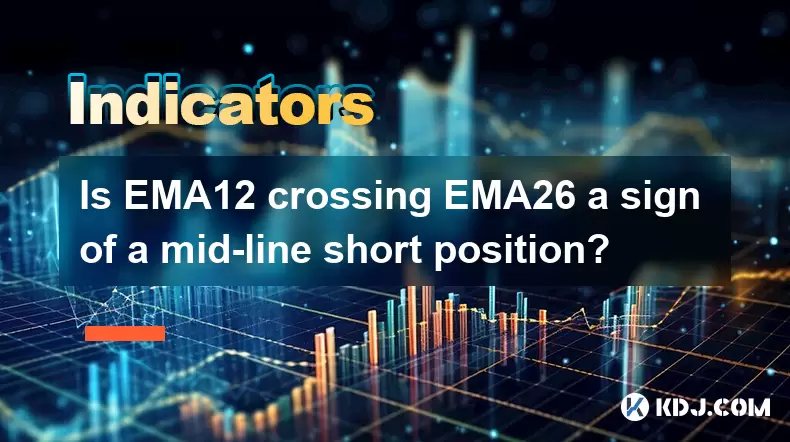
Is EMA12 crossing EMA26 a sign of a mid-line short position?
Jun 16,2025 at 07:22pm
Understanding EMA12 and EMA26 in Cryptocurrency TradingIn the world of cryptocurrency trading, Exponential Moving Averages (EMAs) are widely used tools for analyzing price trends. Specifically, the EMA12 and EMA26 are two of the most commonly referenced EMAs among traders. The EMA12 represents a short-term moving average calculated over the past 12 time...
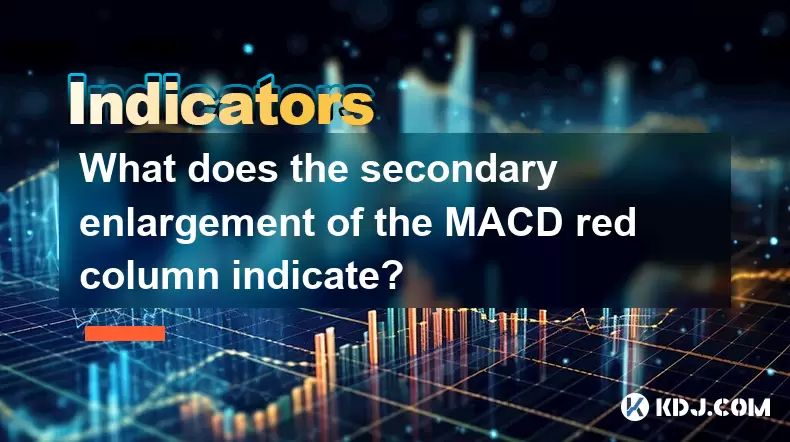
What does the secondary enlargement of the MACD red column indicate?
Jun 16,2025 at 07:49pm
Understanding the MACD Indicator and Its ComponentsThe Moving Average Convergence Divergence (MACD) is a widely used technical analysis tool in cryptocurrency trading. It consists of three main components: the MACD line, the signal line, and the MACD histogram. The histogram, represented as red or green bars, reflects the difference between the MACD lin...
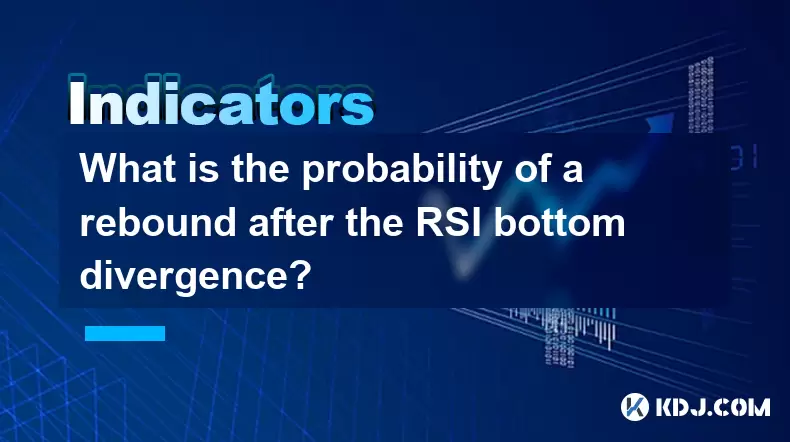
What is the probability of a rebound after the RSI bottom divergence?
Jun 16,2025 at 06:50pm
Understanding RSI Bottom Divergence in Cryptocurrency TradingThe Relative Strength Index (RSI) is a widely used momentum oscillator in technical analysis, particularly within the cryptocurrency market. It helps traders identify overbought or oversold conditions and potential reversal points. A bottom divergence occurs when the price of an asset makes a ...
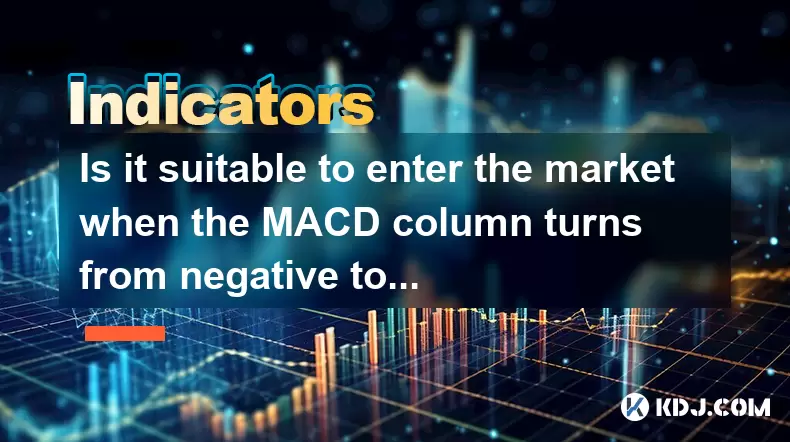
Is it suitable to enter the market when the MACD column turns from negative to positive?
Jun 16,2025 at 06:07pm
Understanding the MACD IndicatorThe Moving Average Convergence Divergence (MACD) is a widely used technical analysis tool in cryptocurrency trading. It consists of three main components: the MACD line, the signal line, and the MACD histogram (often referred to as the MACD column). The MACD line is calculated by subtracting the 26-period Exponential Movi...

How to set the stop profit point after the high-level propeller pattern?
Jun 16,2025 at 08:04pm
Understanding the High-Level Propeller PatternThe high-level propeller pattern is a technical analysis formation often observed in cryptocurrency trading charts. It typically appears at significant price peaks and signals potential reversals. The pattern consists of a large candlestick with long upper and lower shadows, resembling a propeller, indicatin...

When is the most reasonable stop loss after the three crows pattern?
Jun 16,2025 at 08:14pm
Understanding the Three Crows Pattern in Cryptocurrency TradingThe three crows pattern is a well-known bearish reversal signal in technical analysis, particularly relevant in volatile markets like cryptocurrency. It typically appears at the end of an uptrend and consists of three consecutive long red (or bearish) candles with progressively lower closes....

Is EMA12 crossing EMA26 a sign of a mid-line short position?
Jun 16,2025 at 07:22pm
Understanding EMA12 and EMA26 in Cryptocurrency TradingIn the world of cryptocurrency trading, Exponential Moving Averages (EMAs) are widely used tools for analyzing price trends. Specifically, the EMA12 and EMA26 are two of the most commonly referenced EMAs among traders. The EMA12 represents a short-term moving average calculated over the past 12 time...

What does the secondary enlargement of the MACD red column indicate?
Jun 16,2025 at 07:49pm
Understanding the MACD Indicator and Its ComponentsThe Moving Average Convergence Divergence (MACD) is a widely used technical analysis tool in cryptocurrency trading. It consists of three main components: the MACD line, the signal line, and the MACD histogram. The histogram, represented as red or green bars, reflects the difference between the MACD lin...

What is the probability of a rebound after the RSI bottom divergence?
Jun 16,2025 at 06:50pm
Understanding RSI Bottom Divergence in Cryptocurrency TradingThe Relative Strength Index (RSI) is a widely used momentum oscillator in technical analysis, particularly within the cryptocurrency market. It helps traders identify overbought or oversold conditions and potential reversal points. A bottom divergence occurs when the price of an asset makes a ...

Is it suitable to enter the market when the MACD column turns from negative to positive?
Jun 16,2025 at 06:07pm
Understanding the MACD IndicatorThe Moving Average Convergence Divergence (MACD) is a widely used technical analysis tool in cryptocurrency trading. It consists of three main components: the MACD line, the signal line, and the MACD histogram (often referred to as the MACD column). The MACD line is calculated by subtracting the 26-period Exponential Movi...
See all articles

























































































